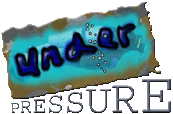Cause:
DCS or Decompression Sickness is a disease caused by Nitrogen, Oxygen, or
Helium bubbles build up in the bloodstream and cause a blockage. Helium blockages
almost never occur in Sport Divers. This is because helium comprises less
than 1% of air. Helium blockages are more common in technical divers and professional
divers, due to the fact that most of them use an air mixture called trimix,
which has roughly 30% helium.
Nitrogen is dissolved in your tissues and bloodstream. When you descend, Boyle's law dictates that the volume of the gas dissolved in your bloodstream will decrease. As such, there will be more space for dissolved gas, and more gas will diffuse into them from the air that you breathed in. As such, the percentage of the air that is nitrogen will still be around 78% and the percent of air that is oxygen will still be around 21%. However, because there is more gas in your body, there will be more oxygen and nitrogen in it than before. When you ascend, Boyle's law dictates that the volume of the gas dissolved in your bloodstream and tissues will increase. As such, there will be less space for dissolved gas, and the amount of gas equal to the amount of gas that diffused in will diffuse out of your bloodstream and tissues, into your lungs, and you will exhale it as you ascend. However, if you ascend at a rate which causes the gas to expand faster than it is being exhaled, the gas may clump together to form bubbles in your tissues, and/or bloodstream. This, as you can imagine is very painful.
Risk Factors:
Patent foramen ovale:
A Patent foramen ovale, which is a hole between the right and left ventricle that can sometimes allow blood to skip the lungs (this name of this skipping is right to left shunt), can increase the risk of DCS 2-5 times. The reason that the risk is increased is that the blood that skips the lungs doesn't have a chance to get rid of any of the buildup of gas that has occurred in it. Additionally, some research suggests that a gaseous pulmonary embolism, a blockage of the blood vessels in the lungs due to gas, may increase pressure in the right side of the heart leading to right-to-left shunt and to a paradoxical arterial embolism. (In other words, a blockage that forms in one's veins and then is passed through a PFO to the arterial circulation(Dipak, <http://www.utdol.com/utd/content/topic.do?topicKey=ad_emerg/3059&view=print>).
Previous Case(s) of DCS:
There is a noticeable increase in your chance of getting DCS a second time
if you continue to dive. However, at this time, it is unknown why. Some cases
of DCS such as spinal cord injury can permanently disqualify one from diving(Piantadosi).
Other:
Because of the decreased pressure in a plane during flight, divers should
wait 12-24 hours before flying in a plane after diving. In some studies, men
have been shown to have a higher risk of DCS than women; however, no conclusive
theories have been established as to why(Dipak, <http://www.utdol.com/utd/content/topic.do?topicKey=ad_emerg/3059&view=print>.
Due to the fact that you are breathing more, which accelerates your nitrogen
uptake, heavy exertion may increase one's chances of getting DCS. Finally,
temperature can also play a role. This is because the volume of a gas shrinks
when it gets cold. As such, cold water may increase one's chances of getting
DCS. Additionally, cold water has the indirect effect of forcing one to wear
heavier exposure protection. This causes the diver to exert herself/himself
more.
Symptoms:
Symptoms are usually exhibited within 12-48 hours after completing a dive
and can include discomfort, fatigue, aches, and lack of appetite(Dipak, <http://www.utdol.com/utd/content/topic.do?topicKey=ad_emerg/3059&view=print>.
Effects:
There are two types of decompression sickness, Type I and Type II.
Type I:
Type I decompression sickness is the least harmful of the two. Effects include
joint pain, itching (especially around the base of the neck), and obstruction
of the lymph system(Dipak, <http://www.utdol.com/utd/content/topic.do?topicKey=ad_emerg/3059&view=print>.
Type II:
Type two decompression sickness is extremely harmful and can lead to death.
Effects include damage to the upper regions of the spinal cord and brain which
may cause weakness, lack of bladder control, memory loss, sight problems,
and ataxia which is difficulty with balance, otherwise known as "the
staggers"(Dipak, <http://www.utdol.com/utd/content/topic.do?topicKey=ad_emerg/3059&view=print>.
Long Term:
One thing, thought to be a long term effect of DCS is Osteonecrosis. Osteonecrosis,
which literally means "bone death" is thought to be caused by bubbles
left over from DCS that cause blockages of the blood vessels that lead to
the bone. This causes the bone to eventually die.
When someone has been identified with decompression sickness, they should be administered 100% oxygen until they get to a recompression chamber. The oxygen helps to get rid of the excess gas faster. Then the person must undergo hyperbaric oxygen therapy. This is where the affected diver is exposed to a high pressure environment to shrink the bubbles back down, and then slowly brought back up to normal, pressure, exhaling the gas normally. There are two ways to perform hyperbaric oxygen therapy (recompression). These are using a hyperbaric recompression chamber, and using in water recompression. In water recompression consists of getting the person back underwater. However, this can be very difficult and is discouraged by DAN, a leading authority on scuba saftey(Diver's Alert Network, <http://www.diversalertnetwork.org/medical/faq/faq.asp?faqid=47>). Recompression treatment usually consists of multiple treatments of the course of a few weeks, to a month. Extended treatment in a recompression chamber can lead to oxygen poisoning, dry cough (from the dry air), near sightedness, and a decrease in pulmonary function. However, getting treatment in a recompression has a 75% complete recovery rate in Type II patients(Dipak, <http://www.utdol.com/utd/content/topic.do?topicKey=ad_emerg/3059&view=print>.
